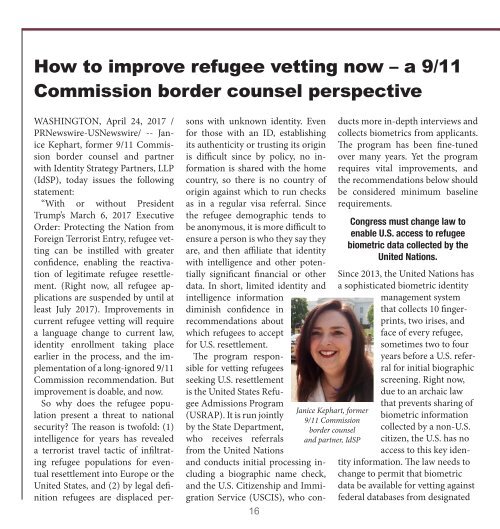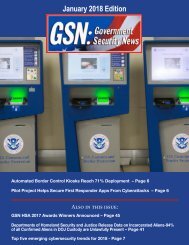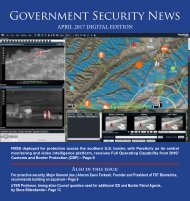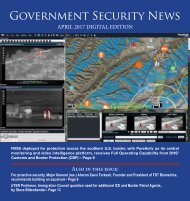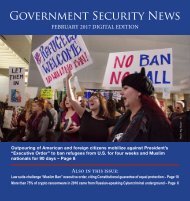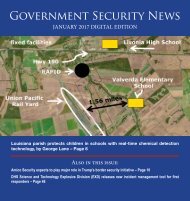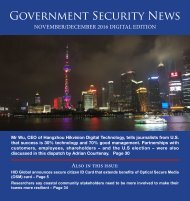GSN_Apr_FINAL+links
Create successful ePaper yourself
Turn your PDF publications into a flip-book with our unique Google optimized e-Paper software.
How to improve refugee vetting now – a 9/11<br />
Commission border counsel perspective<br />
Janice Kephart, former<br />
9/11 Commission<br />
border counsel<br />
and partner, IdSP<br />
WASHINGTON, <strong>Apr</strong>il 24, 2017 /<br />
PRNewswire-USNewswire/ -- Janice<br />
Kephart, former 9/11 Commission<br />
border counsel and partner<br />
with Identity Strategy Partners, LLP<br />
(IdSP), today issues the following<br />
statement:<br />
“With or without President<br />
Trump’s March 6, 2017 Executive<br />
Order: Protecting the Nation from<br />
Foreign Terrorist Entry, refugee vetting<br />
can be instilled with greater<br />
confidence, enabling the reactivation<br />
of legitimate refugee resettlement.<br />
(Right now, all refugee applications<br />
are suspended by until at<br />
least July 2017). Improvements in<br />
current refugee vetting will require<br />
a language change to current law,<br />
identity enrollment taking place<br />
earlier in the process, and the implementation<br />
of a long-ignored 9/11<br />
Commission recommendation. But<br />
improvement is doable, and now.<br />
So why does the refugee population<br />
present a threat to national<br />
security? The reason is twofold: (1)<br />
intelligence for years has revealed<br />
a terrorist travel tactic of infiltrating<br />
refugee populations for eventual<br />
resettlement into Europe or the<br />
United States, and (2) by legal definition<br />
refugees are displaced persons<br />
with unknown identity. Even<br />
for those with an ID, establishing<br />
its authenticity or trusting its origin<br />
is difficult since by policy, no information<br />
is shared with the home<br />
country, so there is no country of<br />
origin against which to run checks<br />
as in a regular visa referral. Since<br />
the refugee demographic tends to<br />
be anonymous, it is more difficult to<br />
ensure a person is who they say they<br />
are, and then affiliate that identity<br />
with intelligence and other potentially<br />
significant financial or other<br />
data. In short, limited identity and<br />
intelligence information<br />
diminish confidence in<br />
recommendations about<br />
which refugees to accept<br />
for U.S. resettlement.<br />
The program responsible<br />
for vetting refugees<br />
seeking U.S. resettlement<br />
is the United States Refugee<br />
Admissions Program<br />
(USRAP). It is run jointly<br />
by the State Department,<br />
who receives referrals<br />
from the United Nations<br />
and conducts initial processing including<br />
a biographic name check,<br />
and the U.S. Citizenship and Immigration<br />
Service (USCIS), who conducts<br />
more in-depth interviews and<br />
collects biometrics from applicants.<br />
The program has been fine-tuned<br />
over many years. Yet the program<br />
requires vital improvements, and<br />
the recommendations below should<br />
be considered minimum baseline<br />
requirements.<br />
Congress must change law to<br />
enable U.S. access to refugee<br />
biometric data collected by the<br />
United Nations.<br />
Since 2013, the United Nations has<br />
a sophisticated biometric identity<br />
management system<br />
that collects 10 fingerprints,<br />
two irises, and<br />
face of every refugee,<br />
sometimes two to four<br />
years before a U.S. referral<br />
for initial biographic<br />
screening. Right now,<br />
due to an archaic law<br />
that prevents sharing of<br />
biometric information<br />
collected by a non-U.S.<br />
citizen, the U.S. has no<br />
access to this key identity<br />
information. The law needs to<br />
change to permit that biometric<br />
data be available for vetting against<br />
federal databases from designated<br />
international partners such as the<br />
United Nations.<br />
Refugees must be biometrically<br />
enrolled the first time they enter the<br />
U.S. system.<br />
State does not collect any biometrics<br />
from refugees, and thus only<br />
has the word of the refugee as to<br />
who they are, making the required<br />
biographic checks a potential goose<br />
chase. While USCIS does collect<br />
rolled prints and a face photo at the<br />
time of the interview, current vetting<br />
against some U.S. biometric<br />
holdings do not return results for<br />
up to 24 hours, after the interview<br />
is already over. If State collected<br />
the biometrics as part of their prescreening<br />
interviews conducted<br />
by their Resettlement Service staff,<br />
USCIS interviews would be better<br />
informed, and so would the final assessment.<br />
Implement the 9/11 Commission<br />
recommendation for a<br />
person-centric immigration system.<br />
State and USCIS use different case<br />
filing assignments for refugees.<br />
Policy does not require that State<br />
initiate a file number that USCIS<br />
recognizes or uses in the processing<br />
of the ultimate immigration benefit<br />
the refugee seeks. Thus, each applicant<br />
has two different file numbers,<br />
creating disconnect and potential<br />
for confusion and duplication. Yet<br />
Pelco showcases latest<br />
technology innovations and<br />
strategic application solutions<br />
Continued from page 11<br />
ExSite Enhanced HD Cameras<br />
are explosion proof and virtually<br />
indestructible with performance<br />
features that include: a robotically<br />
welded housing for use in extreme<br />
conditions; a unique patent-pending<br />
pan-tilt drive system devoid of<br />
belts, gears or pulleys; operation in<br />
the problem could be eliminated<br />
entirely if case numbers were eradicated<br />
and the 9/11 Commission<br />
recommendation for a biometricbased<br />
identity number for the entire<br />
immigration system were put in its<br />
place. When biometrics become the<br />
baseline for any immigration encounter,<br />
identity is protected and<br />
the automatic creation of a timeline<br />
of immigration encounters reduces<br />
fraud and increases efficiencies for<br />
legal immigration. Implementation<br />
of this long ignored 9/11 Commission<br />
recommendation could drastically<br />
improve the U.S. immigration<br />
system, and with it, refugee vetting<br />
as it stands today.”<br />
Contact: Janice Kephar , (202) 750-<br />
4858, SOURCE Identity Strategy<br />
Partners (IdSP)<br />
16 17<br />
extreme temperatures; 30X optical<br />
zoom with image stabilization; IR<br />
illumination; 130dB WDR; 0.03 lux<br />
ultra-low light performance; integrated<br />
Ethernet, fiber, Ethernet over<br />
Coax (EoC) and Unshielded Twisted<br />
Pair (UTP) transmission, and<br />
more. ExSite is an exceptional imaging<br />
solution for oil and gas facilities,<br />
chemical plants, manufacturing and<br />
marine facilities, and for numerous<br />
other demanding environments.<br />
For more information or to schedule<br />
a demo, contact evgeni.tochev@<br />
schneider-electric.com or visit www.<br />
pelco.com.<br />
About Pelco by Schneider Electric<br />
Pelco by Schneider Electric is a<br />
global leader in professional video<br />
surveillance and security system<br />
products and technologies with<br />
a local presence in 136 countries<br />
and over 4000 integration partners<br />
worldwide. Our personal engagement<br />
with customers, resellers and<br />
technology partners drives the development<br />
and deployment of surveillance<br />
and security solutions<br />
with meaningful innovation. It’s the<br />
foundation that Pelco has built its<br />
brand upon for over 25 years.


